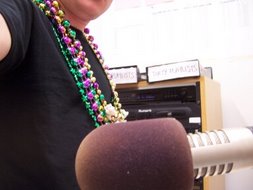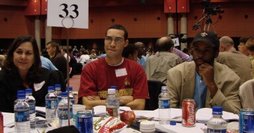
On the 2nd Friday of this year’s New Orleans Jazz & Heritage Festival, a powerful storm struck the city. Up to 5 inches fell in some neighborhoods, streets flooded, and power outages caused several pump stations to shut down temporarily. The Times Picayune headline:
“Downpour: New pumps fail a major test as a strong storm knocks out power and downs trees, but Jazzfest takes it all in stride” (5/5/07)
As clouds broke over the city, festival-goers crowded under tents and kept the party going. The paper showed photos of people in plastic bags and a child belly-flopping in a puddle on the fairgrounds. The show must go on, and fans rocked out to ZZ Top as the sky cleared.
A transit strike had already wreaked havoc on their transportation to Gentilly, as 61 of the 65 bus and streetcar drivers (65!) had called in sick in search of a new contract. This, too, did little to deter the hearty souls here to listen to the music of Counting Crows and other acts.
And so it goes. We can still throw a party. Have no fear, faux Hemingway-types and your straw-hatted wives! Your money is still good here, is the best money around, and we are happier than ever to serve you. Please disregard the still broken drainage system, not yet tested by the Army Corp; the old lady stuck in her car under an overpass, fortunately rescued; the old man who bludgeoned his wife and brother-in-law to death across the lake after years of “crazy-talk” and 2 previous murder convictions; the new school superintendent from Philly, whose wife and kids will live in Chicago during his term, he’ll commute, thankyouverymuch; those menacing black teenagers with the gold teeth and Lil’ Wayne braids, growing up in their own private Haiti, gearing up for a long, hot summer.
Ignore all of that: onstage at the Fest and in the clubs tonight, you’ll hear the truth: THIS is New Orleans! A boozy kiss from one Hawaiian shirt to another while the blues jam rages. THIS is New Orleans! Restaurant capital of the world, land of the open-container! THIS is New Orleans!
All for you and as you please.
“Downpour: New pumps fail a major test as a strong storm knocks out power and downs trees, but Jazzfest takes it all in stride” (5/5/07)
As clouds broke over the city, festival-goers crowded under tents and kept the party going. The paper showed photos of people in plastic bags and a child belly-flopping in a puddle on the fairgrounds. The show must go on, and fans rocked out to ZZ Top as the sky cleared.
A transit strike had already wreaked havoc on their transportation to Gentilly, as 61 of the 65 bus and streetcar drivers (65!) had called in sick in search of a new contract. This, too, did little to deter the hearty souls here to listen to the music of Counting Crows and other acts.
And so it goes. We can still throw a party. Have no fear, faux Hemingway-types and your straw-hatted wives! Your money is still good here, is the best money around, and we are happier than ever to serve you. Please disregard the still broken drainage system, not yet tested by the Army Corp; the old lady stuck in her car under an overpass, fortunately rescued; the old man who bludgeoned his wife and brother-in-law to death across the lake after years of “crazy-talk” and 2 previous murder convictions; the new school superintendent from Philly, whose wife and kids will live in Chicago during his term, he’ll commute, thankyouverymuch; those menacing black teenagers with the gold teeth and Lil’ Wayne braids, growing up in their own private Haiti, gearing up for a long, hot summer.
Ignore all of that: onstage at the Fest and in the clubs tonight, you’ll hear the truth: THIS is New Orleans! A boozy kiss from one Hawaiian shirt to another while the blues jam rages. THIS is New Orleans! Restaurant capital of the world, land of the open-container! THIS is New Orleans!
All for you and as you please.
++++++++++++++++++++++++++++++++++++++++++++
“BLOW YOUR HORN!!”
This Parrothead motherfucker in front of me wants Trombone Shorty to play the thing, damn it, and stop all this singing. It’s the first day of the festival, and this guy’s not havin’ it. He whines like he’s been caught in the middle of a game of keep-away, “Give me my ball baaaack!” and wrinkles his brow in his wife’s direction like a child whenever Shorty opens his mouth. When a rapper comes on stage for a verse, the little guy in the Hawaiian shirt slumps his shoulders, bears through it. His slurred assessment, if you were to ask him:
“The kid wants to do all this hip-hop shit, singing and putting on a show, when what he needs to do is blow! He’s an amazing player, he’s Trombone Shorty, not Rapper Shorty, you know what I mean?”
When Shorty and Orleans Avenue kick it into high gear, though, the reddened critic dances and throws his arms in the air, really digs it. This is what he paid for, fuck-n-A.
At the end of the set, Shorty decides to leap from the stage and make his exit down the aisle cleared through the middle of the crowd. The stage is a little too high, though, and the kid flubs the landing, has to straighten his coat and sunglasses before strutting out. Certainly he killed it today, but he almost broke his neck doing it.
+++++++++++++++++++++++++++++++++++++++++++++
I’ve been reading a book on Storyville that I bought Kim for her birthday. Along with thousands of bizarre characters and set-ups, “sports” and “madams,” hypocrisy and piano genius, there are black and white pictures of the District and its denizens. Recognizing the old mansions and crib houses is impossible for me, as all but a building or two is left from that fabled section.
Yet I can tell that the sky is bright in the extraordinary, brash way it is now. That has not changed. And as much as things changed from then until 10 years ago when I first arrived, and from then through the storm until today, I find some comfort in that sky’s infinite glare. Benign comfort is presently at a premium.
+++++++++++++++++++++++++++++++++++++++++++++
“BLOW YOUR HORN!!”
This Parrothead motherfucker in front of me wants Trombone Shorty to play the thing, damn it, and stop all this singing. It’s the first day of the festival, and this guy’s not havin’ it. He whines like he’s been caught in the middle of a game of keep-away, “Give me my ball baaaack!” and wrinkles his brow in his wife’s direction like a child whenever Shorty opens his mouth. When a rapper comes on stage for a verse, the little guy in the Hawaiian shirt slumps his shoulders, bears through it. His slurred assessment, if you were to ask him:
“The kid wants to do all this hip-hop shit, singing and putting on a show, when what he needs to do is blow! He’s an amazing player, he’s Trombone Shorty, not Rapper Shorty, you know what I mean?”
When Shorty and Orleans Avenue kick it into high gear, though, the reddened critic dances and throws his arms in the air, really digs it. This is what he paid for, fuck-n-A.
At the end of the set, Shorty decides to leap from the stage and make his exit down the aisle cleared through the middle of the crowd. The stage is a little too high, though, and the kid flubs the landing, has to straighten his coat and sunglasses before strutting out. Certainly he killed it today, but he almost broke his neck doing it.
+++++++++++++++++++++++++++++++++++++++++++++
I’ve been reading a book on Storyville that I bought Kim for her birthday. Along with thousands of bizarre characters and set-ups, “sports” and “madams,” hypocrisy and piano genius, there are black and white pictures of the District and its denizens. Recognizing the old mansions and crib houses is impossible for me, as all but a building or two is left from that fabled section.
Yet I can tell that the sky is bright in the extraordinary, brash way it is now. That has not changed. And as much as things changed from then until 10 years ago when I first arrived, and from then through the storm until today, I find some comfort in that sky’s infinite glare. Benign comfort is presently at a premium.
+++++++++++++++++++++++++++++++++++++++++++++

As I reach the Gentilly Stage in search of Eddie Bo, one of the first acts of the festival, I find a large pavilion, with elevated bleachers and people sitting 8 feet high in the shade of a Mardi Gras-colored tent. A sign on the tent reads, “BIG CHIEF EXPERIENCE.” So this is what it’s come to: at Jazzfest, one can become a BIG CHIEF, meaning (according to the festival’s website):
* Daily Admission to JAZZ FEST
Entry and re-entry for each day you hold a Big Chief ticket. (No car re-entry.)
* Access to VIP Viewing Stands
Big Chief customers have access to raised and covered private viewing areas with beverage concessions and restrooms at the two main stages, Acura and Gentilly. Seating is first-come, first-served. At 3 other stages, Big Chief ticket holders will have semi-private access to a viewing area at the Congo Square/Louisiana Rebirth Stage, at ground level in front of the stage, and at side-stage viewing areas at the AT&T/WWOZ Jazz Tent and the Southern Comfort Blues Tent.
* Access to a Private Air-conditioned VIP Hospitality Lounge
Renew and revitalize with complimentary light refreshments and full-service restrooms.
* A Jazz Fest Program Guide
I walk to the wall in front of the bleachers and stare up at the BIG CHIEFS.
Now, when you hear the title “Big Chief” in New Orleans, it refers to a Mardi Gras Indian chief, the hallowed leader of a tribe. Many of these men are legends in the city, their names remembered for decades in talk and songs—“here comes the Big Chief….” Here on the fairgrounds of 2007, this means anyone with $600 to spend on 3 days of comfortable listening.
“Sonofabitch,” I say to myself.
Because I understand that times are tough and we all need the money, need to take advantage of what we have left. When I see a movie crew blocking up a street and some chick from Manhattan hissing into a walkie-talkie next to a buffet table, I no longer get heated, or curse. When Hollywood couples buy blocks of the Quarter, I say, thanks for the spotlight. Regardless of who he is, I cheer on the tourist, for he is our greatest cash cow, and I will stop to give him directions regardless of his condition.
But is this worth it? Is the selling of higher ground among the great, even field of the fairgrounds crowd, is that expendable in these times? Will we cede our democratic shoulder rubbing for the comfort of baby boomers? Does enough money trickle down to local people to justify the debasement of a sacred title? Is that the future we have to look forward to?
Fuck the BIG CHIEF EXPERIENCE. If the Jazzfest people have no problem whoring to that division, it won’t be long before Shell Oil executives pay for the privilege to sit in with their favorite band. And if the city’s character wasn’t defeated by the storm, it will surely be defeated then.
+++++++++++++++++++++++++++++++++++++++++++++
I move on and, when called upon, dance in a circle with a group of shy Houma Indians in the section between stages where the Native Americans demonstrate their culture. The drummer’s beat mingles with the sound of Zydeco that bleeds over from the Fais Do-Do stage. A few school children join us, but most people stand on the edge of the circle, hesitant and awkward. After the dance ends, I speak to an old man carving a wooden duck about the best places to visit in Houma, LA, then I eat two Indian tacos next to a blacksmith exhibit.

I remember that the jazz funeral parade for 60 Minutes reporter and festival-lover Ed Bradley runs at 1pm. Near the main gate, I find the tail of the parade and join the crowd around the band. Someone holds up a placard showing Bradley with a tambourine in his hand. I once saw Bradley riding a golf cart at Jazzfest.
At the center of the funeral parade, I see the trombonist Corey Henry. Nowadays, Corey’s like an old head on the scene, and whenever I see him, I can’t help but think back to when he was just a kid like I was, playing with Kermit Ruffins, drinking Bud Lights with the world on a string. Corey looks like he’s aged sorta fast, and I wonder if I have, too, and wonder how things have worked out for everyone.

Back at the Congo Square stage, the Amazones, a group of women drummers from Guinea, have the crowd right where they want them. Consisting of three lead drummers, two lead dancers, and a line of secondary drummers in the rear, the women play the best set I hear all day. The three lead drummers also sing, in that fast tenor of West Africa, and step forward for solos that evolve into a competition of crowd response. My favorite is on the stage left and she points to her self in mid-beat, demanding the cheers. Someone near me mentions that this is, technically, a heretic act—women aren’t allowed to play drums in that culture. That may be true, but I would hate to be the man who tried to stop these women.
I walk to the Southern Comfort Blues tent and rest my feet during a sound check. Then I make my way to the AT&T/WWOZ Jazz tent and listen to 2 songs from Astral Project before moving on, predictably. I stop off in a tent for Acura, one of the festival’s sponsors. Several new cars sit under large screens featuring car ads, and salespeople drift around the showroom floor. After a couple more cans of beer, I return to Congo Square and listen to Kirk Joesph’s Backyard Groove play “War (What is it good for?)” to a crowd that languidly sings along. Then the band’s white rapper attempts to rock the mic. The war sure is far away, I think, and the people here today are an impenetrable lot, focused on getting their kicks in the bosom of the apocalypse.

Maybe I’m just a little frailer, though, because the beer slows me down enough that I have to sit down and shade my face from the sun. My mind wanders. I recall the mispronunciations of the day—“that’s the Fi Doo Doo stage right there”—and wonder how everyone got here, how they found out about the Jazzfest in the first place. I think about the strange fellow at the planning meeting three months ago, how he really put it together.
“What they do,” he told the recovery committee, “is take Asian food and cook it with another ethnic food—they call that fusion, ok? Fusion restaurants, that’s what we’re gonna end up with, ok?”
That loony fucker was right, I think. The leisure class is strong and likes it easy, and they will find everything edible and they will eat it. The pretense of authenticity, of roots, that’s all fine and good, but what’s most important is what’s easy. People come here for that, and all we’re left with now is hard, hard, and slow.
My muddling ends when the emcee announces the eminent appearance of Trombone Shorty and Orleans Avenue.
++++++++++++++++++++++++++++++++++++++++++++++
On the second Friday of the festival, the day of the rain storm, I stood in the brand new auditorium in the building where I work. A podium with thousands and thousands of dollars worth of multimedia equipment sat in one corner, with a set of flags in the other, 120 new seats for the audience, a state-of-the-art projector in the ceiling, and artwork by John Scott on the wall. A pool of water spread across the floor, under the podium and seats. The streets outside had flooded and as cars passed, they caused waves to lap against the building, and run under the emergency door of the auditorium. I watched the water run over our new tile floors in a room built for interactive education, and I wondered what would happen if….
++++++++++++++++++++++++++++++++++++++++++++++
“BLOW YOUR HORN!”
This plaintive cry comes around the third song of the set, after the cover of “Back in Black,” the chorus of which Shorty does not sing. That’s a shame, as it would be a great, simple political statement.
The set is not without its subtle politics, though. A great syncopated horn line frames a song with the chorus, “Where is the party?” but its single verse is a description of the perils of going out at all. Shorty continues to reinvent “St. James Infirmary,” and I think that’s a statement in itself.
Look, this is a former Jackson Square kid from Treme, descended from a musically rich family. He knows what’s gone down for a few hundred years, knew the anthems since before he could talk (apparently an unfortunate development for some experts). Handsome and unbelievably talented, Shorty could rest on a mastery of nostalgia and deal out the tightest, safest funk in town, and rake in the loot.
He’s not doing that, though. Trombone Shorty takes risks.
The risks aren’t simply stage-diving, though they often have similar results. His showmanship belongs to a 21-year old, and he can go too far in spots. Clearly he wants it all, and bringing an MC into the fold is a reach, even if it pretty much succeeds. See, the kid is not playing around, not adding in a variety act to nod towards hip-hop and R&B. Instead, he has a DJ/Mixer as part of the band, and increasingly works that in with good results. The beats and horn lines are James Brown, sure, but they’ve come via Pete Rock. Shorty might not have the greatest voice, but he’s using it all the time, and that’s where the risk is.
“BLOW YOUR HORN!”
If a risk is inherently consequential, then one risk involves smaller risks, or they travel in packs, more than one shadow crossing the void with you in the leap to the next rooftop. The risks of living here are ubiquitous, and include threats as small as petty crime and as large as the total disappearance of the wetlands within 10 years. As a result of these conditions, the only music I’m interested in right now is the one that takes chances, that grabs for new ideas, that has the balls to want it both ways, and that is suitably weird. The same standards could apply to the resurrection of this city.
“BLOW YOUR HORN!”
But our charge is greater than simply rebuilding and staving off another flood. We’re also required to rebuild the museum, and by that I mean the playland/depository that New Orleans is in the mind of the nation. The idealized vision of the city is a place of libertines, of slow pace, of dances in old houses, where you can eat what you want and get plowed. Again, as progress leveled distinctions in the rest of the country, New Orleans stood out in relief and attracted visitors bent on some “authentic,” wild n’ crazy vacation.
Now there’s a strange class of people who come every year, and expect an all-access pass to a rum-fueled fantasy of outlaw America, without danger and with little struggle. Festivals dedicated to Heritage turned into Baby’s First Bacchanalia, while the poor filled up the flood plane. Sadly, and like a good whore, New Orleans excels at delivering the goods, even if the bed is rotten and rent is way past due. The problem is, that deal had the city on its knees before the storm, and will keep it on its back if it continues. Suffering and smiling is not going to get us out of this mess.
So if Troy “Trombone Shorty” Andrews chooses to disrupt that exchange by following his own vision, I’m still with him. Much has changed in my view of New Orleans over the last year, but the changes in Shorty are worth the time, worth the risk.
+++++++++++++++++++++++++++++++++++++++++++++
As I write this, two men, one fat and one skinny, hack away at the roof across the street. They tear off sections of the blue tarp that covers the diamond shaped shingles and begin to hammer, it’s not clear why. The wind picks up and the tarp blows wildly. The fat one stands on the ladder and whacks away at a long plank holding down a section of tarp. The skinny one tries to rip off shingles with his claw hammer, then disappears to the other side of the house.
I’ve seen variations of this routine from my window over the last 6 months. I remain uncertain what their goal is, and expect them to reattach the tarp at the end of the day. Probably the roof sprung a few leaks during the rain yesterday and the guys are only patching them up. Or perhaps they’ll tear the whole thing off and start over. Both men appear unsure of the proper course, but they continue to climb up there, careful not to fall, figuring things out as they go.











